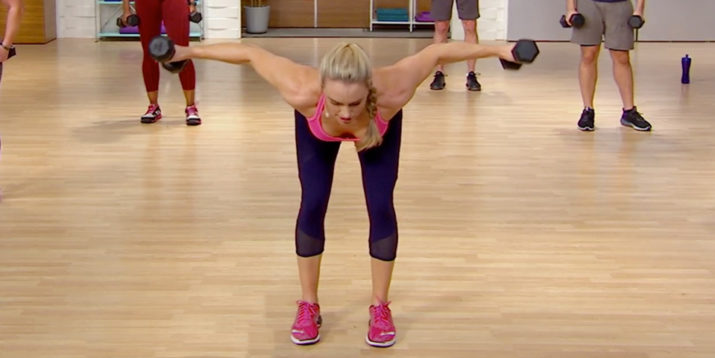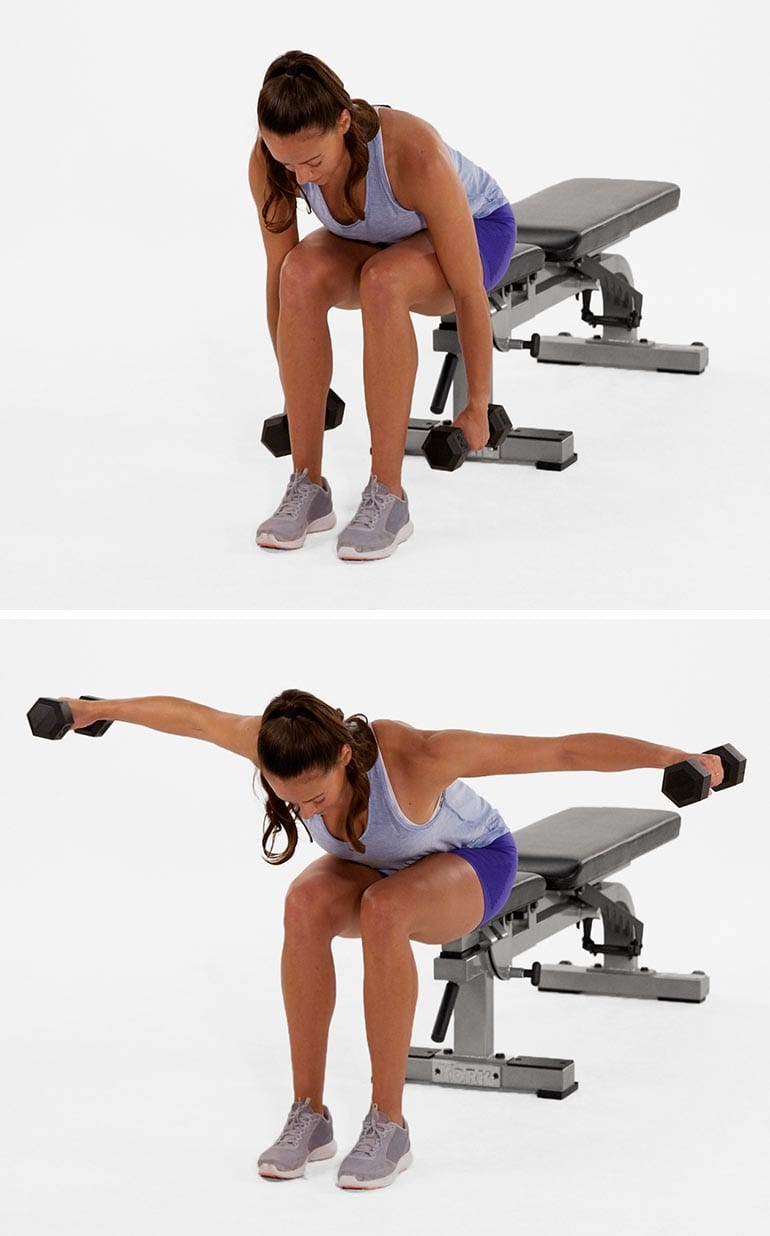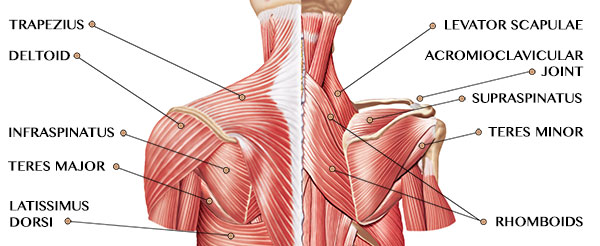How to Do a Dumbbell Reverse Fly, Plus 3 Variations to Try

Moment of truth: Right now, you’re probably hunched over a computer screen, phone, or tablet. It’s an inevitable outcome of the digital age we live in, and while the technology is great for communication and dispersing information, it can really take a toll on your body.
Thankfully, you can mitigate some of the side effects of slouching by doing an exercise called the dumbbell reverse fly. (It’s not to be confused with a lateral raise, which is performed with a more upright posture and targets the lateral (side) delts.)
Here’s how to do the dumbbell reverse fly with perfect form and some variations you can add to your workout routine.
Dumbbell Reverse Fly: Step-by-Step Instructions
- Stand with your feet shoulder-width apart, holding a dumbbell in each hand.
- Hinge at the hips (press the hips back as you lower your chest) until your chest is almost parallel with the ground. Allow the weights to hang straight down at arm’s length, palms facing each other.
- Keeping your back flat, core braced, and knees slightly bent, raise your arms out to your sides until they’re in line with your body. Squeeze your shoulder blades together at the top of the movement.
- Return to the starting position, and repeat.
Variations on the Dumbbell Reverse Fly
By making a few tweaks to the angle of your torso, you can hit your muscles in slightly different ways to get even more out of this move.
1. Reverse fly on bench
- Holding a set of dumbbells, sit on a bench or stability ball. With your feet flat on the ground, hinge at the waist to lean forward slightly, and bring your dumbbells behind your calves, palms facing each other.
- With a slight bend at the elbow, raise your arms outward and squeeze your shoulder blades, keeping your palms facing the floor.
- Release your arms slowly and repeat.
2. Post delt fly with resistance bands
Appears in: The Master’s Hammer and Chisel >> Iso Speed Hammer
- Hold the handles of a resistance band and assume a shoulder width stance, using both feet to stand on the center of the band to secure it.
- Exchange handles between your two hands so that the bands cross.
- Bend your knees slightly and hinge at your hips until your torso is almost parallel to the floor and your back is flat. (If necessary, spread your feet wider to create more tension on the band.)
- Keeping your torso still, raise the handles as far as possible directly out to your sides, with the back of your hands facing the ceiling.
- Lower the handles fully, and repeat.
3. Pterodactyl fly
Appears in: P90X3 >> Incinerator
- Holding two light dumbbells at your sides, assume a long, runner’s lunge position, with your stronger leg forward, torso leaning forward, and forming a straight line from your back leg to your head. Keep your back leg straight.
- Keeping your torso still and the back of the hands facing the ceiling, slowly raise the dumbbells directly out to the sides until they are parallel to the floor, squeezing your shoulder blades together.
- Lower the dumbbells to the sides of your ankle and repeat.
4. Cable rear delt fly
- Select a light weight on both stacks of a dual cable machine, and slide the pulleys to around shoulder height.
- Face the machine and take hold of the cable for the stack on the right in your left hand and the cable for the stack on the left in your right hand (the cables will be crossed in front of you).
- Still facing the machine, assume a kneeling position — on a pad if necessary — about two feet behind the front stacks of the cable machine.
- Reach your arms directly forward and upward in front of you, about 45 degrees to the floor. This is your starting position.
- Keeping your arms slightly bent, slowly draw the cables in wide arcs down and behind you, squeezing your rear deltoids as hard as possible in the end position (think of pushing the pinkie-sides of your hands down and outward).
- Slowly reverse the movement, return to the starting position, and repeat for reps.
How to Make the Dumbbell Reverse Fly Easier

- Perform the move from a seated position: By sitting on a bench, you’ll increase stability, so your core doesn’t have to work quite as hard, allowing you to focus entirely on the rear delts, traps, and rhomboids.
- Use lighter weights: You should only lift as heavy as you can while keeping proper form. If you find that you need to use momentum to lift your arms up, go down in weight until you build more strength.
How to Make the Dumbbell Reverse Fly Harder
- Decrease stability: Variations like the pterodactyl fly change your center of gravity, making your legs and core work even harder.
- Slow down the movement: You can do this using dumbbells, but it can be especially effective using resistance bands, which forces you to engages your muscles on the way up and down.
- Use heavier weights: This is an easy way to increase the load on your muscles, as long as you maintain proper form.
Benefits of the Dumbbell Reverse Fly
“Every day, many of us sit at a desk typing, texting, or slouching, which lengthens the fibers of the rear delts and rhomboids,” explains Cody Braun, CSCS.
“The more we are in this position, the more likely these muscles are to become under-active, and the more likely we are to suffer movement dysfunctions.”
In fact, research published in Surgical Technology International shows that this slouched, head-forward position can be equivalent of having up to a 60-pound weight strapped to your neck and upper back.
The result: poor posture, sub-par exercise performance, and an increased risk of injury. The solution: the reverse fly.
While this move alone won’t cure the detriments of slouching, it will help strengthen the rear deltoid, rhomboids, and middle fibers of the trapezius, the ones that aid in scapular (shoulder blade) retraction.
Sure, you could go to a gym and use the reverse cable fly machine, but you can also do this move in the comfort of your own home with just a set of dumbbells.
The dumbbell reverse fly works just as effectively as any machine (and it takes up a lot less space, too).
What Muscles Does the Dumbbell Reverse Fly Work?

The reverse fly hits a number of important muscle groups on your back and shoulders, including the trapezius, rhomboids, and rear deltoids.
Trapezius
This kite-shaped muscle runs vertically along your upper spine and fans out toward your shoulders. The upper traps shrug your shoulders up, the middle portion pulls them back, and the lower traps pull them down. All together, they help you do nearly anything that requires upper body power, like throwing, climbing, swinging, pulling, pressing, and more.
Rhomboids
A series of small muscles that create a diamond-shape across the shoulder blades, the rhomboids primarily help to prevent excess movement in the shoulder blades while you throw and push objects. The rhomboids run from the inner edge of your scapula to your spine.
Rear deltoids
The delts are the meaty part of your shoulder, giving it that buff definition when it’s built out. There are three parts to the deltoid muscle: the front (anterior), middle (lateral), and rear (posterior) fibers. The reverse fly emphasizes the rear fibers of the delts, which moves your arm behind your body when you’re standing, and lifts it to the side when you’re lying on your stomach.
